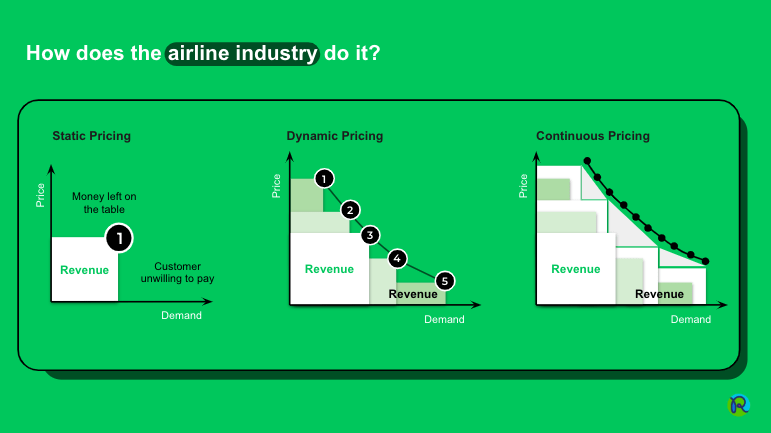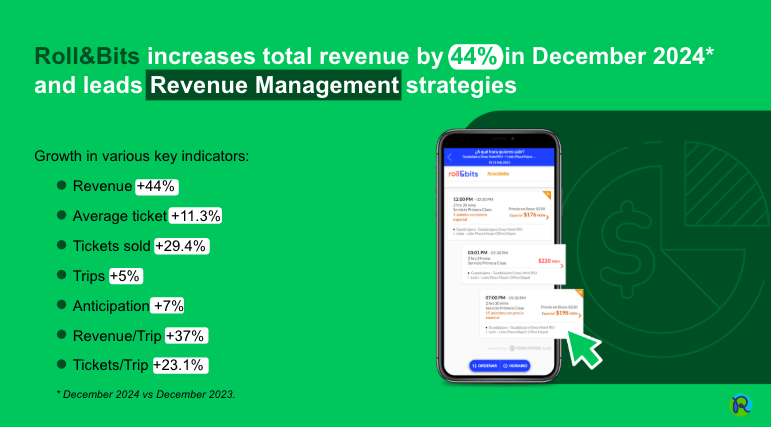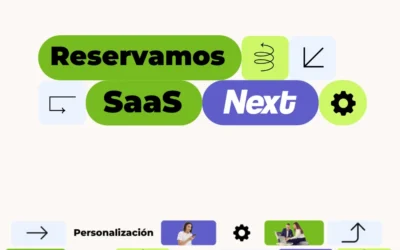The first webinar of the year “Beyond Discounts: Innovative Revenue Management Strategies to Increase Revenue” was focused on sharing best practices and trends in Revenue Management, a key strategy to optimize revenue and enhance the traveler experience.
On January 23, we hosted the first webinar of the year, “Beyond Discounts: Innovative Revenue Management Strategies to Increase Revenue,” bringing together Mitl García, Revenue Management Consultant at Reservamos SaaS; Felix Velazquez, Chief Revenue Officer at Viva; and Humberto Candelaria, Commercial and Marketing Coordinator at Roll&Bits.
The three panelists shared their expertise and industry insights, discussing best practices and trends in Revenue Management—a key strategy for optimizing revenue and enhancing the traveler experience.
Revenue Management: Much More Than Discounts
According to Mitl and Felix, Revenue Management is not just about applying discounts but about implementing strategies to sell the right product to the right customer at the right time and price.
Revenue Management is a strategy focused on maximizing revenue, achieved through price adjustments. – Felix Velazquez, Chief Revenue Officer at Viva.
In sectors like aviation, this involves segmenting passengers based on their needs, purchase timing, and willingness to pay.
One of the key principles of Revenue Management is balancing occupancy with profitability. A full flight doesn’t always mean maximum revenue, as ticket prices and demand play a crucial role. Airlines use dynamic pricing models based on historical data and real-time factors, such as competitor actions or supply reductions.
We must be capable of implementing optimal revenue strategies. The number of price points we offer travelers is crucial, not only for revenue maximization but also for expanding our customer base. – Felix Velazquez, Chief Revenue Officer at Viva.
Viva’s dynamic pricing strategy has expanded its customer base by catering to different fare levels. Diversifying prices not only increases revenue but also attracts more passengers.

Revenue Management is not just about applying discounts or increasing spending from existing customers. Its value lies in expanding the offering and creating more opportunities for customers to access our product. – Felix Velazquez, Chief Revenue Officer at Viva.
The Power of Data and Segmentation in Revenue Management
When distinguishing why Revenue Management is more than just a temporary promotion, Mitl explained that data analysis plays a key role in understanding this difference.
Revenue Management is not merely a discount strategy; it is a methodology that requires market maturity and a deep understanding of consumers. – Mitl García, Revenue Management Consultant at Reservamos SaaS.
Mitl emphasized that successfully applying Revenue Management requires historical data, demand patterns, competitor movements, and real-time analysis. This strategy also requires support from other teams, such as marketing, to ensure customers are aware of available purchase options.
It doesn’t work on its own. It takes effort and patience. In the end, it’s here to stay and delivers great results. The airline and hotel industries have paved the way for other sectors. – Mitl García, Revenue Management Consultant at Reservamos SaaS.
Additionally, Mitl pointed out that Revenue Management is about optimizing pricing through the relationship between supply and demand. Rather than applying discounts, it’s about understanding what price different customer segments are willing to pay at different times.
He illustrated this with examples from other industries, such as movie theaters, where ticket prices vary depending on the day and time, or fashion, where end-of-season discounts help maximize inventory revenue before new collections arrive.
In transportation, once a flight or bus departs, that seat can no longer be sold. Since it is perishable, we must focus on maximizing it before the departure date. – Mitl García, Revenue Management Consultant at Reservamos SaaS.
To implement Revenue Management strategies that maximize revenue, it’s essential to establish a base fare. Mitl recommended focusing on three key points:
- Costs: Pricing should be based on a clear understanding of costs. Operating a bus from point A to point B has associated costs that must be factored in.
- Competitors: Understanding competitors’ offerings and pricing structures is crucial.
- Market Share: Knowing your market share helps define strategies to gain ground or defend your position.
Pricing Strategies and Calculated Risks
In a highly competitive market like ground transportation, taking risks is necessary. However, as Mitl pointed out, the sector often hesitates to implement new strategies or adopt competitor tactics.
We know that taking risks can impact revenue, which is why it’s essential to do so in a calculated way. The key is to test short-term strategies, experiment with innovative approaches, and always consider the market context and specific route where an unconventional tactic will be applied. – Mitl García, Revenue Management Consultant at Reservamos SaaS.
How Can I Calculate and Minimize That Risk?
To optimize decision-making without compromising profitability, it’s crucial to implement strategies that allow for evaluating the impact of price changes. Some best practices include:
- A/B testing on similar routes: Comparing the performance of one route with an aggressive strategy versus another without changes helps identify trends and measure the real impact on growth.
- Short trial periods: When applying aggressive discounts, it’s essential to monitor customer behavior weekly using digital tools to track interactions, clicks, and purchase anticipation.
- Strategic profitability limits: Setting a controlled loss margin for a specific period (e.g., accepting a 20% revenue reduction over three months) allows for evaluating returns without compromising business sustainability.
Beyond just maximizing revenue, Revenue Management enables companies to anticipate demand and offer a personalized purchasing experience. Its success lies in the combination of technology, strategic analysis, and execution aligned with the market, making it an essential pillar for the evolution of the industry.
Smile Bus: Use of Promotional Fares and Ongoing Support to Increase Revenue
One of the greatest success stories in implementing innovative Revenue Management strategies is Smile Bus, a Mexican ground transportation company. Through a structured approach and constant support from the Reservamos SaaS team, they have optimized their pricing strategy and increased their market share.
The Key Factors Behind Smile Bus’ Success
- Strategic Support and Follow-Up Sessions. Weekly sessions to adjust strategies in real-time, address questions, and ensure that pricing aligns with market demand. This ongoing support is crucial for companies without an in-house Revenue Management team, providing constant guidance and expert advice on price optimization.
- Implementation of Teaser Fares to Maximize Occupancy. This strategy, widely used in the airline industry, offers aggressive fares during low-demand periods. It encourages occupancy and attracts travelers who had not originally planned to take a trip. To maximize impact, the company reinforced communication about the discounts through social media and physical sales channels.
- Clear Definition of Goals and Market Segmentation. Ensuring an effective strategy without compromising profitability. Discounts are applied at strategic times to maintain financial balance, attract new customers, and increase market participation.
Thanks to a combination of dynamic pricing and effective marketing campaigns, Smile Bus has strengthened its presence and increased its passenger volume. Their well-structured Revenue Management strategy—backed by data analysis and precise marketing execution—has enabled them to maximize revenue without compromising profitability.
To read the full success story, click here.
Roll&Bits: Evolving Toward Dynamic Pricing with Technology
Roll&Bits, a Mexican digital passenger transportation company, has evolved its operational model by replacing terminals with strategic boarding points and adopting a dynamic pricing strategy instead of fixed fares. During the webinar, Humberto Candelaria, Commercial and Marketing Coordinator at Roll&Bits, emphasized that one of the most valuable lessons they have learned is that, in the transportation sector, having a dedicated Revenue Management team is not a requirement for effective pricing management: You can manage it yourself. That makes it a daily challenge.
The integration of Revenue Management tools has optimized operations and increased the number of users. According to Humberto, the key is not simply applying discounts but strategically adjusting prices based on demand.
It’s not about offering a discount just because. You need to analyze the segment and the market. The key is knowing when to implement aggressive strategies and when not to. There’s no need to fear using a bold pricing strategy. Optimizing prices according to demand is essential. This analysis has allowed us to increase our average ticket price month after month by adjusting fares based on operational performance and market demand. – Humberto Candelaria, Commercial and Marketing Coordinator at Roll&Bits.
However, Revenue Management alone is not enough. Its success depends on a well-aligned marketing strategy that encourages advance purchases. In Humberto’s words: It’s about encouraging travelers to plan, to book early, so they get a reasonable price without perceiving our offer as simply ‘cheap.’
By leveraging advanced tools, Roll&Bits has refined its commercial strategy, analyzing route performance to predict demand up to two months in advance and adjust fares in real-time.
A key advantage is that we can change fares instantly. We don’t have to wait and see what happens in the market before reacting. This level of flexibility has given us a significant competitive edge, allowing us to optimize sales and improve profitability. – Humberto Candelaria, Commercial and Marketing Coordinator at Roll&Bits.
The implementation of Revenue Management has been a game-changer for Roll&Bits, enabling them to increase profits without compromising service quality.

To read the full success story, click here.
The adoption of innovative Revenue Management strategies has proven to be a key driver for revenue optimization across multiple industries. Through customer segmentation, data analysis, and dynamic pricing, companies like Viva, Smile Bus, and Roll&Bits have successfully balanced profitability and occupancy, increasing sales without relying solely on discounts.




